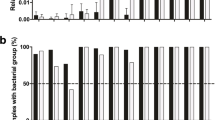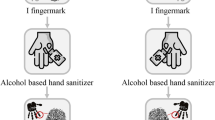Abstract
As it is unclear if and how long DNA evidence can persist on submerged skin, we examined the potential for recovery of touch DNA and blood stain DNA from skin samples immersed in different aquatic environments and temperatures for forensic purposes in this proof-of-concept study. We used pig skin, either smeared with human blood or held firmly for 30 s by two test-persons, before immersing it in either cold, room-temperature or warm water as well as in a stream and a pond for up to seven days prior to DNA testing. The samples were then typed at 16 STR loci. Cold water samples yielded the most promising results, as shown by the recovery of the full set of 16 reproducible STR loci from the touch DNA sample of one test-person after 7 days. For blood stains, we were able to recover all 16 reproducible STRs after 2 days. Room-temperature water and warm water yielded varying results for both blood stain DNA and touch DNA. For pond and stream samples, DNA recovery was possible only within two days. While the pond and stream samples were at relatively cold temperatures, DNA recovery may have been affected by the presence of water insects and snails in the pond and mud in the stream. Our findings show the potential of using immersed samples, particularly those immersed in cold water, as we could detect a complete DNA profile from blood stains and from touch DNA after several days. Our study opens the way for future in-depth studies, examining larger datasets and a wider range of conditions.






Similar content being viewed by others
References
Wickenheiser RA. Trace DNA: a review, discussion of theory, and application of the transfer of trace quantities of DNA through skin contact. J Forensic Sci. 2002;47:442–50.
Wickenheiser RA. Suspect DNA profiles obtained from the handles of weapons recoverd at crime scenes. 1999; 10th Annual Syposium on Human Identification, Lake Buena Vista, Florida.
van Oorschot RA, Jones MK. DNA fingerprints from fingerprints. Nature. 1997;387:767.
van Oorschot RA, Ballantyne KN, Mitchell RJ. Forensic trace DNA: a review. Investig Genet. 2010;1. https://doi.org/10.1186/2041-2223-1-14.
Dziak R, Peneder A, Buetter A, Hageman C. Trace DNA sampling success from evidence items commonly encountered in forensic casework. J Forensic Sci. 2018;63:835–41.
Wiegand P, Kleiber M. DNA typing of epithelial cells after strangulation. Int J Legal Med. 1997;110:181–3.
Hammer U, Bulnheim U, Karstädt G, Meissner D, Wegener R. Zur DNA-Typisierung übertragener Hautzellen nach körperlicher Gewalt. Rechtsmedizin. 1997;7:180–3.
Rutty GN. An investigation into the transference and survivability of human DNA following simulated manual strangulation with consideration of the problem of third party contamination. Int J Legal Med. 2002;116:170–3.
Lowe A, Murray C, Whitaker J, Tully G, Gill P. The propensity of individuals to deposit DNA and secondary transfer of low level DNA from individuals to inert surfaces. Forensic Sci Int. 2002;129:25–34.
Kanokwongnuwut P, Martin B, Kirkbride KP, Linacre A. Shedding light on shedders. Forensic Sci Int Genet. 2018;36:20–5.
Goray M, Fowler S, Szkuta B, van Oorschot RAH. Shedder status-an analysis of self and non-self DNA in multiple handprints deposited by the same individuals over time. Forensic Sci Int Genet. 2016;23:190–6.
Bowman ZE, Mosse KSA, Sungaila AM, van Oorschot RAH, Hartman D. Detection of offender DNA following skin-to-skin contact with a victim. Forensic Sci Int Genet. 2018;37:252–9.
Raymond JJ, van Oorschot RA, Gunn PR, Walsh SJ, Roux C. Trace evidence characteristics of DNA: a preliminary investigation of the persistence of DNA at crime scenes. Forensic Sci Int Genet. 2009;4:26–33.
Pfeifer CM, Gass A, Klein-Unseld R, Wiegand P. DNA persistence of bite marks on food and its relevance for STR typing. Int J Legal Med. 2017;131:1221–8.
McLeish K, Ferguson S, Gannicliffe C, Campbell S, Thomson PIT, Webster LMI. Profiling in wildlife crime: recovery of human DNA deposited outside. Forensic Sci Int Genet. 2018;35:65–9.
Sweet D, Shutler GG. Analysis of salivary DNA evidence from a bite mark on a body submerged in water. J Forensic Sci. 1999;44:1069–72.
Borde YM, Tonnany MB, Champod C. A study on the effects of immersion in river water and seawater on blood, saliva, and sperm placed on objects mimicking crime scene exhibits. Can Soc Forensic Sci J. 2008;41:149–63.
Frippiat C, Gastaldi A, Van Grunderbeeck S. Persistence of immersed blood and hair DNA: a preliminary study based on casework. J Forensic Legal Med. 2017;51:1–8.
Helmus J, Zorell S, Bajanowski T, Poetsch M. Persistence of DNA on clothes after exposure to water for different time periods-a study on bathtub, pond, and river. Int J Legal Med. 2018;132:99–106.
Kallupurackal V, Kausel T, Sulzer A, Voegeli P, Kratzer A. Automating PrepFiler® forensic DNA extraction kit: optimization and validation on freedom EVO® 150. Forensic Sci Int Genet Suppl Ser. 2015;5:e101–e3. https://doi.org/10.1016/j.fsigss.2015.09.041.
Burger J, Hummel S, Hermann B, Henke W. DNA preservation: a microsatellite-DNA study on ancient skeletal remains. Electrophoresis. 1999;20:1722–8.
Nakanishi A, Moriya F, Hashimoto Y. Effects of environmental conditions to which nails are exposed on DNA analysis of them. Leg Med (Tokyo). 2003;5(Suppl 1):S194–7.
Dissing J, Sondervang A, Lund S. Exploring the limits for the survival of DNA in blood stains. J Forensic Legal Med. 2010;17:392–6.
Phipps M, Petricevic S. The tendency of individuals to transfer DNA to handled items. Forensic Sci Int. 2007;168:162–8.
Kamphausen T, Schadendorf D, von Wurmb-Schwark N, Bajanowski T, Poetsch M. Good shedder or bad shedder--the influence of skin diseases on forensic DNA analysis from epithelial abrasions. Int J Legal Med. 2012;126:179–83.
Kwok YL, Gralton J, McLaws ML. Face touching: a frequent habit that has implications for hand hygiene. Am J Infect Control. 2015;43:112–4.
Quinones I, Daniel B. Cell free DNA as a component of forensic evidence recovered from touched surfaces. Forensic Sci Int Genet. 2012;6:26–30.
Hefetz I, Einot N, Faerman M, Horowitz M, Almog J. Touch DNA: The effect of the deposition pressure on the quality of latent fingermarks and STR profiles. Forensic Sci Int Genet. 2019;38:105–12.
van Oorschot RAH, Szkuta B, Meakin GE, Kokshoorn B, Goray M. DNA transfer in forensic science: a review. Forensic Sci Int Genet. 2019;38:140–66.
Purps J, Geppert M, Nagy M, Roewer L. Validation of a combined autosomal/Y-chromosomal STR approach for analyzing typical biological stains in sexual-assault cases. Forensic Sci Int Genet. 2015;19:238–42.
Fonnelop AE, Ramse M, Egeland T, Gill P. The implications of shedder status and background DNA on direct and secondary transfer in an attack scenario. Forensic Sci Int Genet. 2017;29:48–60.
Szkuta B, Ballantyne KN, van Oorschot RAH. Transfer and persistence of DNA on the hands and the influence of activities performed. Forensic Sci Int Genet. 2017;28:10–20.
Acknowledgements
We thank Valeria Hofer, Simon Gentile, Eddie Surer, Kathrin Schäfer, Jakob Heimer, Markus Enders and Daniel Huber for the help during the experiments, and Natasha Arora and Guro Dorum for their valuable comments on this manuscript.
Author information
Authors and Affiliations
Corresponding author
Additional information
Publisher’s note
Springer Nature remains neutral with regard to jurisdictional claims in published maps and institutional affiliations.
Electronic supplementary material
ESM 1
(PDF 417 kb)
Rights and permissions
About this article
Cite this article
Meixner, E., Kallupurackal, V., Kratzer, A. et al. Persistence and detection of touch DNA and blood stain DNA on pig skin exposed to water. Forensic Sci Med Pathol 16, 243–251 (2020). https://doi.org/10.1007/s12024-020-00234-3
Accepted:
Published:
Issue Date:
DOI: https://doi.org/10.1007/s12024-020-00234-3




